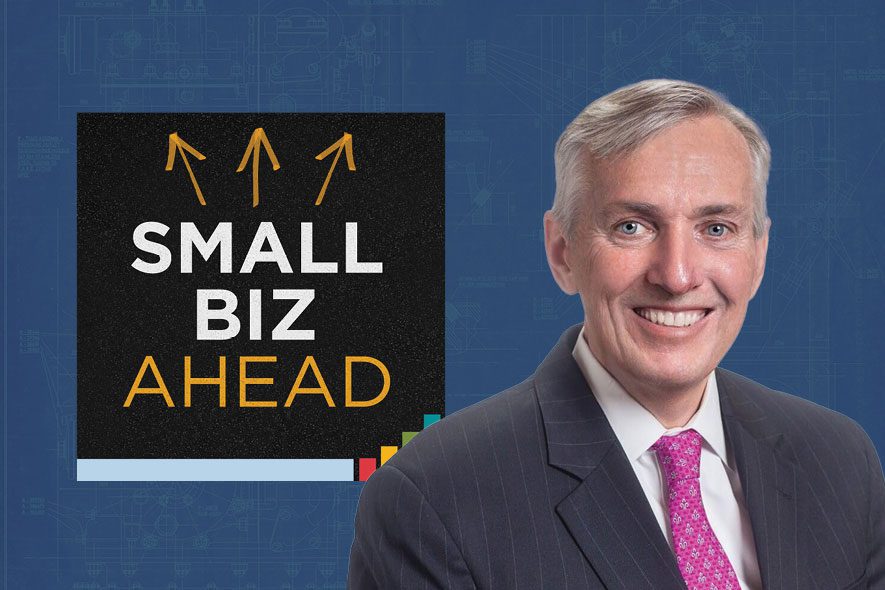Key Podcast Highlights
What Is Shrinkflation?
- Shrinkflation is where you sell something for the same price but you sell a little bit less of it. Some of the largest brands in the country are doing this right now. One example of this strategy would be selling two meatballs with a pasta dinner instead of three but for the same price as before.
Why Use Shrinkflation?
- Companies choose this cash management strategy because it can help maintain margins.
- You first need to look at all your products and services that you’re delivering and then ask yourself if it’s possible to deliver a little bit less.
Transcript
The views and opinions expressed on this podcast are for informational purposes only, and solely those of the podcast participants, contributors, and guests, and do not constitute an endorsement by or necessarily represent the views of The Hartford or its affiliates.
You’re listening to the Small Biz Ahead podcast, brought to you by The Hartford.
Our Sponsor
This podcast is brought to you by The Hartford. When the unexpected strikes, The Hartford strikes back for over 1 million small business customers with property, liability, and workers compensation insurance. Check out The Hartford’s small business insurance at TheHartford.com.
Gene (00:01):
Hey everybody, it’s Gene Marks and welcome to the Hartford Small Biz Ahead podcast. Thank you so much for joining me. This week, I wanna talk to you about a little cash management strategy. Particularly these times of, well, higher inflation obviously, certainly higher costs. We’re trying to maintain our overhead. For many of us we’re facing a sluggish economy or sluggish demand. And obviously every penny counts. And people, people are often asking like how do we get by? Should we, can we get away with raising prices again in this inflationary environment? And I think you will agree that, most companies did raise prices over the past couple years as inflation, was what it was. But now that inflation has been brought a bit under control, less companies are using that as a strategy.
Gene (00:48):
Even though we are still facing higher costs of production. I mean, typical materials cost. I mean, if you’re running a restaurant or you’re running a even a B2B like a manufacturing, and you look at your, your cost of labor and utilities and core materials in your products, the cost of food, the cost of rent, they’re all up way more than double digits in just the past two to three years. So we still need to do something to maintain our margins. It’s all about maintaining our margins. Now, there are a lot of different strategies that people use to do this to, to keep your margins high. And remember, your margin is whatever your sales revenue is, less your cost of sale, your direct cost of sale, your materials and labor to, to make or produce that item.
Gene (01:33):
That’s your margin, right? You gotta maintain them. Well, one strategy that has been successful for a lot of companies is, believe it or not, something called shrinkflation. Have you ever heard of what shrinkflation is? Shrinkflation is where you sell something for the same price, but just a little bit less of it. Now, that might sound a little unethical or immoral, but it’s not, because some of the largest brands in the country are doing that right now. There are reports and you can Google these all over the place. Some different news sites. I pulled just a few example. Walmart sells great value paper towels. They used to include 168 sheets in a roll of these paper towels. Now there’s only 120 sheets in that roll, but they’re charging the same price for those paper towels. If you wanna buy a bag of Doritos, a bag of Doritos used to be 9.75 ounces. Now it’s 9.25 ounces, same bag, same price, but just a little bit less, a little bit less cost of materials. Charmin toilet paper, if you really want to get down to it. It originally had 650 sheets of per roll. Now it only contains half of that, even their mega rolls, that their super mega rolls….
Gene (02:59):
Don’t have as many sheets as the original because again, they’re charging the same price, but they’re delivering less product. If you go and buy hefty trash bags, their megapack used to be 90 bags, now it’s 80 bags at the same price. Domino’s is putting fewer chicken wings in its carry out baskets. And I dunno who’s getting chicken wings from Domino’s guys? I mean, isn’t it a pizza place, whatever, they’re putting fewer chicken wings in there for the same price. If you go to Burger King, you’re only getting eight nuggets now instead of 10, but it’s still the same price. Do you understand what I’m saying? Shrinkflation is happening all over the place. Go to a typical hotel. It used to be that you would get your room serviced every day or towels or chairs would be included at the pool, but now you’ve gotta pay either a resort fee or they’re just not included.
Gene (03:49):
If you want your room service, you actually have to ask for it to be done. These are all little amenities that big brands have been cutting back while trying to keep the price the same so that their margins are still what they are. And that’s gonna apply to you in 2024. This is a strategy that applies to businesses in all industries. I don’t know how many restaurants I’ve gone to, and I’m sure you’ve seen the same thing where you get spaghetti and meatballs and there’s two meatballs instead of three in the dish. Did we remember that? Wasn’t there used to be three meatballs in this dish? I’m not really sure, whatever, but it’s still the same price. So a lot of restaurants are giving little bit smaller portions of food so they don’t have to increase the price and maintain their margins.
Gene (04:36):
Retailers have mentioned and consumer products are doing the same thing. And even if you’re in a B2B business, even if you’re in the world of construction or the world of manufacturing or distribution, there are ways that you can practice shrinkflation. Whatever you are promising in your quotes and your estimates and your jobs, whatever services you’re promising, take another look at those services and see if there’s a few less services you could be providing, but still keep the price the same. Look at the freight that you’re charging. A lot of companies include freight and when they ship stuff out or they include for a certain area around you, a radius that freight isn’t charged well, maybe you do charge for freight going forward, or maybe your freight, your free freight is only for people that were within an hour distance from your location.
Gene (05:26):
If you provide like ongoing maintenance or support or ongoing services, maybe you cap that and even though you’re not changing the price, you’re not gonna provide an infinite number of maintenance or support services for a product. It’s only gonna go out for 30 days or 60 days, things like that. My recommendation is you should be looking at every type of product that you’re selling, every type of job that you’re doing, and whatever you used to include in the price, you might wanna see where there are places where you can pull back on some of those services or…
Gene (05:56):
Materials while still charging the same price. Try to deliver something a little bit less, but for the same price. So obviously, as long as you’re not sacrificing safety, that’s shrinkflation. And that is what so many companies are doing. They’ve been doing it the past few years and they’re gonna continue to do it in 2024 because we’re in an environment of still challenging economic times with higher cost structures. So my advice to you is, look at all the products and services that you’re delivering and think to yourself, can we deliver or provide a little bit less without increasing the price so that we can maintain our margins? It is all about margins. That’s what you want to think about in 2024. Shrinkflation is real and it is a bonafide strategy for maintaining your margins this year. My name is Gene Marks and you have been listening to the Small Biz Ahead podcast from The Hartford. If you need any advice or help or tips in running your business, please visit us at SmallBizAhead.com or SBA.thehartford.com. Hope you got some good information from this segment. I’ll be back with you next week with some more advice or help in helping you run your business. I look forward to it. Talk to you then.
Download Our Free eBooks
- Ultimate Guide to Business Credit Cards: The Small Business Owner’s Handbook
- How to Keep Customers Coming Back for More—Customer Retention Strategies
- How to Safeguard Your Small Business From Data Breaches
- 21 Days to Be a More Productive Small Business Owner
- Opportunity Knocks: How to Find—and Pursue—a Business Idea That’s Right for You
- 99 New Small Business Ideas






While as a business owner, I understand the need to keep the same margins to run your business, but this is basically raising your prices while hoping the consumer does not realize. You describe going from 168 to 120 paper towels in a roll. That is 30% less product. Have the costs to make that product increased 30%? I doubt it. They have probably increased their margins which a lot of companies are doing currently.
If a company needs to raise their prices to keep their margins, they should be honest about it. As a electrical contractor, I can’t say I’m going to run the wire 80 feet even though I need to run it 100 feet to complete the project. I can be honest and give them available alternatives to reduce the cost, and let the customer decide
I find it very aggravating that groceries are being sold in smaller quantities. I had my first run-in with this when Temptee started selling 11 1/2 oz containers of cream cheese. I went to bake my cheese cake and found myself short on cheese. I switched to Philadelphia now since they still sell 12 oz containers. We are using much more packaging now that coffee went from 1 lb bags to 13oz, to 10oz. I need 3 bags now and still am short a 2-lb purchase. Less product, more packaging.
Thank you for sharing, Karen!